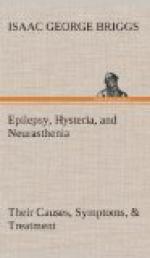5. Sleeplessness. Some patients go to sleep readily, but after some instants wake suddenly, in a state of excitement that persists despite their efforts to calm themselves, and only at an early hour in the morning do they sleep again. Other patients go to bed with the conviction they will not sleep, and are kept awake by incessant cogitation, their minds being harassed by a rapid flow of images, ideas and memories. In some cases the person is calm, his mind is at rest, yet he cannot sleep.
6. Circulatory Disturbances. More blood flows to an organ at work than to one at rest. In health we do not notice these changes, but in neurasthenia these internal tides are exaggerated as rushes of blood to the head, flushings of various parts, and coldness of hands and feet.
Heart palpitation is alarming but not dangerous, and the distended blood-vessels of the ears may set up vibrations in the drum, so that at night when the head is on the pillow, every beat of the heart is heard as a thump, which banishes sleep, and works the victim into a state of high tension. A pain in the chest, arms and elbows is often felt, limbs may swell (shown by the tightness of rings, collars, etc.) while the hands and feet are usually moist and clammy. The patient may have to empty the bladder every half-hour. Disorders of menstruation are common.
7. Mental Fatigue. Hundreds of pages would be needed to describe all the symptoms due to mental fatigue, the morbid belief that the victim has a fatal disease being very common, though his “disease” rarely makes him lie up; in the day he works, at night describes his symptoms to the home circle.
The inability of most men to apply themselves steadfastly to any one set of ideas is seen in the immense popularity of music halls, cinemas, and short-story magazines, which offer a change of interest every few minutes.
In normal people there is a slight consciousness of mental processes, but the mind rarely watches itself work; the neurasthenic is unable to concentrate, and gets charged with inconstancy and shiftlessness.
His ideas are restive, continuous thought is impossible, and when talking he has to be “brought back to the point” many times. Memory and attention flag, and he listens to a long conversation, or reads pages of a book without grasping its import, and consequently he readily “forgets” what in reality he never laboured to learn. Trembling of limbs is common.
He lacks initiative, and whatever course he is forced to take—after much indecision—he is convinced, a moment later, it would have been wiser to have taken the opposite one.
All his acts are done inattentively. He goes to his room for something, but has forgotten what when he gets there; later, he wonders if he locked the drawer, and goes back to see. At night he gets up to make sure he bolted the door, put out the gas, and damped the fire.
Regret for the past, dissatisfaction with the present, and anxiety for the future are plagues common to most people, but they become acute in a neurasthenic, who reproaches himself with past shortcomings of no moment, infuriates himself over to-day’s trivialities, and frets himself over evils yet unborn.




